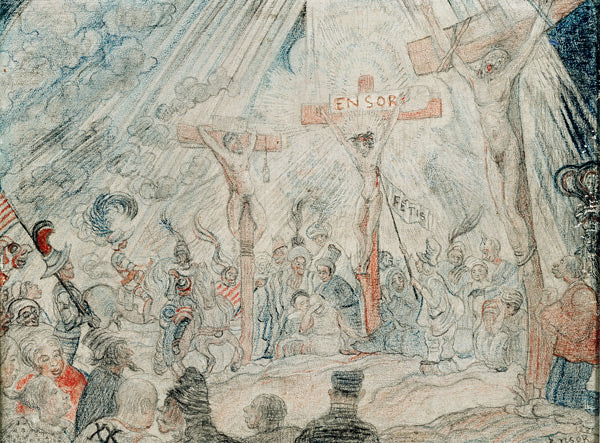Description
The "Calvary" painting of 1886, made by James Ensor, is a work that mixes the grotesque and the sublime in a unique representation of the Christian theme. In this piece, Ensor shows his ability to combine a rich color palette and a composition loaded with symbolism, which reveals his characteristic style of symbolism and expressionism. The work presents a scene of the crucifixion that, although anchored in a religious context, unfolds in an environment of strangeness and surrealism that challenges conventional interpretations.
Visually, "Calvary" is distinguished by its bold color use. The scene is impregnated with vibrant tones that contrast with the shadow that surrounds the figures. Desor uses a range of intense colors ranging from the burning red of the sky to the whites and yellow that highlight the backs of the figures in the foreground. This color choice drives the emotional intensity of the work and makes it a very personal expression vehicle.
As for the composition, the work is dense and almost chaotic. The spectator is attracted to the melting of characters that populate the canvas, each with expressions that can be interpreted as burlescas or tragic. The central figure of Christ appears crucified, but surrounded by a crowd that includes both common people and a series of grotesque and masks that are a constant in the sour work. In this context, the masks not only enrich the dramatic content, but also symbolize the duality of the human being and the nature of suffering. This use of the grotesque is a distinctive element of the design style that indicates its interest in the absurd and criticism of social hypocrisy.
The atmosphere of the work is enhanced by the complexity of the positions of the figures, which seem to move in a whirlwind of torn emotions. In his vast work, he often used the influence of his personal experiences and his environment, which manifests here in the representation of the agony suffered, not only by Christ, but also by a crowd that could represent the human condition in his whole.
"Calvary" can be seen in the context of the artistic development of Areor, who experienced with themes of life and death, the sacred and the profane. Thus, this work is not only inscribed in the tradition of religious art, but opens the door to the exploration of symbolism and social criticism. In this sense, we can place "Calvary" within a broader framework of contemporary works that address the representation of suffering in art, such as the works of Vincent Van Gogh or even in the most modern art that arises in the twentieth century.
Through "Calvary", James Ensor not only celebrates the tragedy of the crucifixion, but also offers the viewer a reflection on the nature of human pain, faith and existence. The interaction of the crowd, expressions and colors invite a deep meditation on sacrifice and its impact on the human psyche. This work, although monumental and particular, reveals the ability to teach to dialogue with the universal themes that are going through art history. In its complexity, "Calvary" is erected as a testimony of the Master's degree and its innovative approach towards the interpretation of human experience.
KUADROS ©, a famous paint on your wall.
Hand-made oil painting reproductions, with the quality of professional artists and the distinctive seal of KUADROS ©.
Art reproduction service with satisfaction guarantee. If you are not completely satisfied with the replica of your painting, we refund your money 100%.

